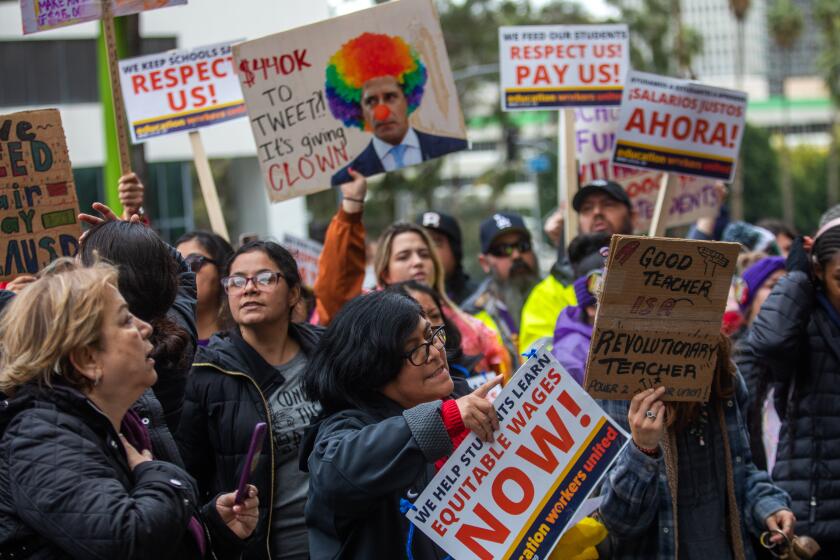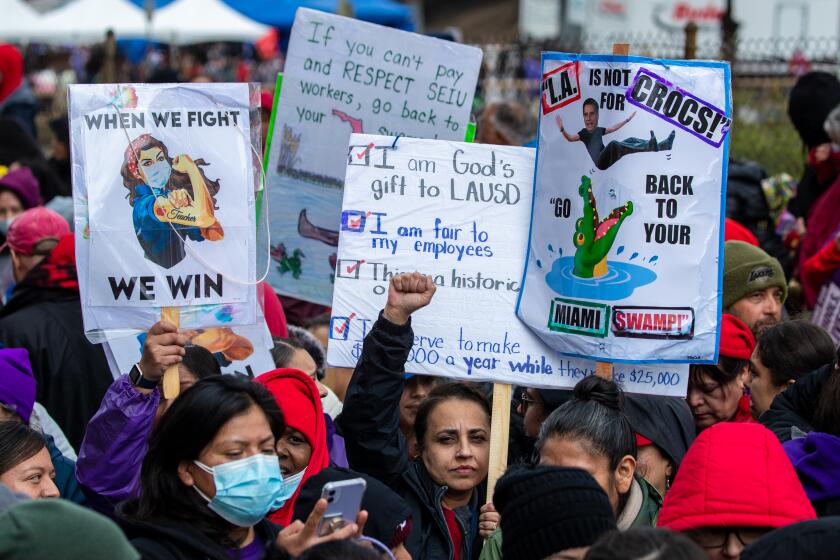How the high cost of housing pushed many LAUSD workers to strike
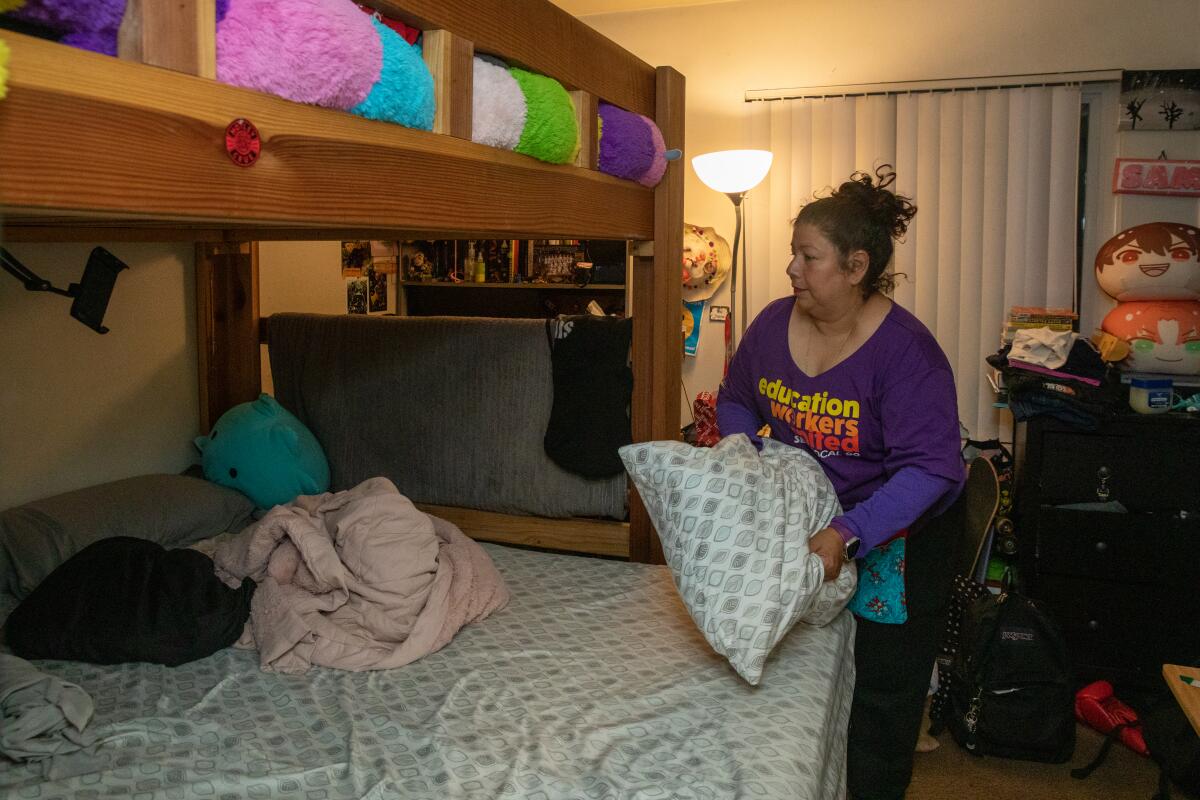
- Share via
Before the sun rose, Yadira Martinez, a special education assistant at Florence Avenue Elementary School in South L.A., shuttled around her tiny kitchen, sauteing eggs and potatoes to share with her fellow strikers earlier this week on the picket line.
She joked about the tight confines: “You turn around, take one step and you’re at the sink.”
Martinez, 53, has worked for L.A. Unified for 28 years, spending her days caring for young children with disabilities, changing their diapers, feeding them and teaching them. She makes about $32,000 a year and lives in low-income housing, paying $1,450 a month for a two-bedroom, one-bath, 750-square-foot apartment.
She shares a bed with her 18-year-old granddaughter; her teenage daughter sleeps on the bunk above them. Her dresser is in the living room, across from a small sewing station where she makes aprons, which she sells to supplement her income.

“It’s a dream of mine to have my own room,” she said.
For Martinez and many other public school workers who went on strike for three days this week, the crux of their fight is the ability to live decently in Los Angeles, where the exorbitant cost of housing exerts a brutal burden on the working class, forcing families to live in overcrowded homes or pushing workers to commute for hours to more affordable communities.
The average yearly wage of the bus drivers, custodians, special education assistants, cafeteria workers and other members of Local 99 of Service Employees International Union is $25,000. The median rent for a newly listed one-bedroom apartment in L.A. County was $1,619 in February, according to Apartment List — more than $19,400 per year.
In a survey of about 3,300 members conducted by the union last year, about 10% of workers reported having been homeless at some point while working for the district. Nearly 30% reported being at “high risk” of becoming homeless.
L.A. Unified has recognized its workers’ struggles to pay for housing, and in the last several years has worked with nonprofit developers to complete three affordable housing projects across the district.
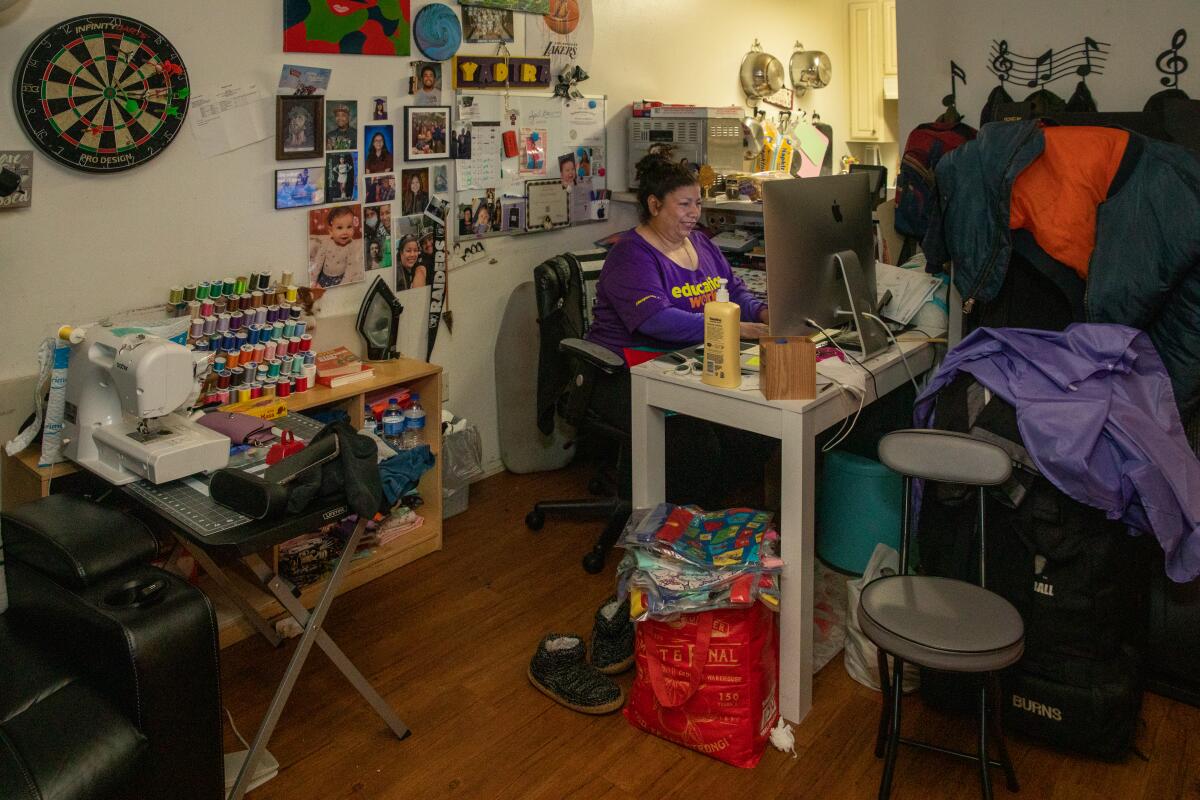
Those projects resulted in 185 units in complexes in Gardena, Hollywood and South L.A., more than 80% of which were leased to district employees. The district is also exploring the possibility of additional housing projects, said district spokeswoman Shannon Haber.
She said L.A. Unified “has led the affordable housing for employees effort in the state and until recently, the District was the only school district in California to do so.”
But the district’s housing projects reach only a limited number of workers, and each one has a wait list with more than 100 people.
Workers say the biggest effect would come from bigger salaries.
California workers from fast food to school staff are demanding better wages and benefits through legislation backed by unions.
“The district is the second-largest employer in L.A. County,” said Blanca Gallegos, an SEIU Local 99 spokeswoman. “To address the issue of homelessness that everybody has been talking about, one way is to improve jobs and improve wages so that people working here in Los Angeles can live here in the city.”
The union is aiming to raise the average yearly wage of its workers to $36,000 — a 30% raise plus an additional $2 an hour for the lowest paid. The strike, which the union has said is meant to protest alleged unfair labor practices, ended Thursday with Mayor Karen Bass set to continue mediating the dispute.
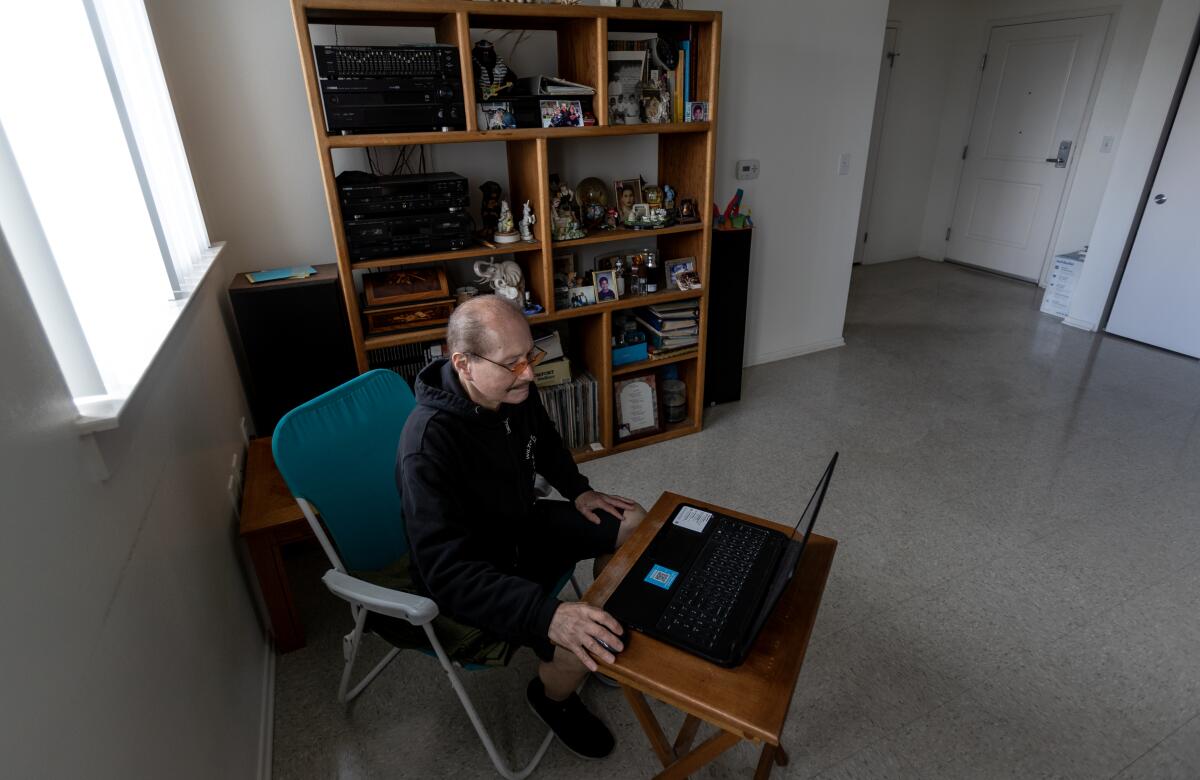
Henry Argueta, 68, has worked for the district as a special education assistant since 2008. He is among the staffers who managed to secure a unit in one of the district’s affordable housing projects in Hollywood. Before that, he rented a small studio in Pico-Union that had been converted from a motel room.
“You could barely walk in there,” he said. “The heater was working, but there was no air conditioning at all. And it got really hot.”
His new place is a one-bedroom with air conditioning, heating, underground parking and a view of Sunset Boulevard. But his rent has gone up since he moved in three years ago. He now pays about $1,300 a month — or nearly half of the $32,890 he earned last year in his job with the district. He works a second job helping on political campaigns to make ends meet.

“I am very lucky to pay what I’m paying right now,” he said. But, he added, “it’s still not that affordable.”
Gary Payne, 59, a buildings and grounds worker at San Pedro High School, has worked for the district for about 10 years and earns just under $20 an hour. He works full time, which puts him in a better position than many of his co-workers in the union who work only part time. Still, he said he had to move to Menifee in order to be able to afford a home.
His commute is 90 miles each way. He wakes up long before dawn and drives for Uber on his way to San Pedro, in order to help pay his mortgage and other bills.
“I’m pushing it,” he said. But he keeps going to ensure that he’ll be able to retire in a few years.
Martinez was in her 20s, working as a waitress and going to college, unsure about what she would do with her life, when a friend asked whether she would be interested in working at a school with kids with disabilities. She started as a volunteer and quickly fell in love with the job, she said. When she’s on campus she feels like a second parent to the kids.

“If they fall and they hit their knees, we hug them,” she said. “If they’re not feeling well, we know.”
She starts her work day early in the morning, supervising children on the school bus, which she started doing to earn extra pay.
“Those hours help a lot,” she said.
A few years ago, she started making aprons with pockets that are designed for school workers to keep their supplies — tissue, hand sanitizer, markers, keys. She scouts fabrics with prints of Dr. Seuss, Disney and other characters on sale at Walmart and sells them for $13 each.
She makes ends meet with the help of her son, Leonardo Hernandez, 24, who also works for the district as a buildings and grounds worker. Hernandez has autism, and Martinez is glad that he found a job where he has the support and understanding of his co-workers. But she wishes she didn’t have to rely on him.
“I want to be able to pay the rent by myself,” she said.
The three-day strike that has closed L.A. schools means many of the district’s lowest-paid workers will lose three days of wages while on the picket line. Many say it’s worth it.
Before moving into the Huntington Park apartment where she now lives, Martinez lived with her brother at a house in South L.A. She had her own room then, she said. But there was a lot of violence in the community, and she felt she had to leave to keep her kids safe.
“Now we’re just stuck here because everything went up and we cannot move,” she said. “We can’t afford $2,000 rent. That’s just too much.”
On Wednesday morning, as Martinez and Hernandez got ready for another day of picketing, the thought of the income they were losing to the three-day strike weighed heavily on them. Soon, they would have to pay rent again.
“He’s worried. I’m worried,” she said. “Hopefully it’ll pay out.”
A 30% raise would boost her salary to more than $41,000 a year. With that, she figured, she would be able to move.
“If we win, we’ll probably be able to get out of here,” she said. “Get a place with three bedrooms at least.”
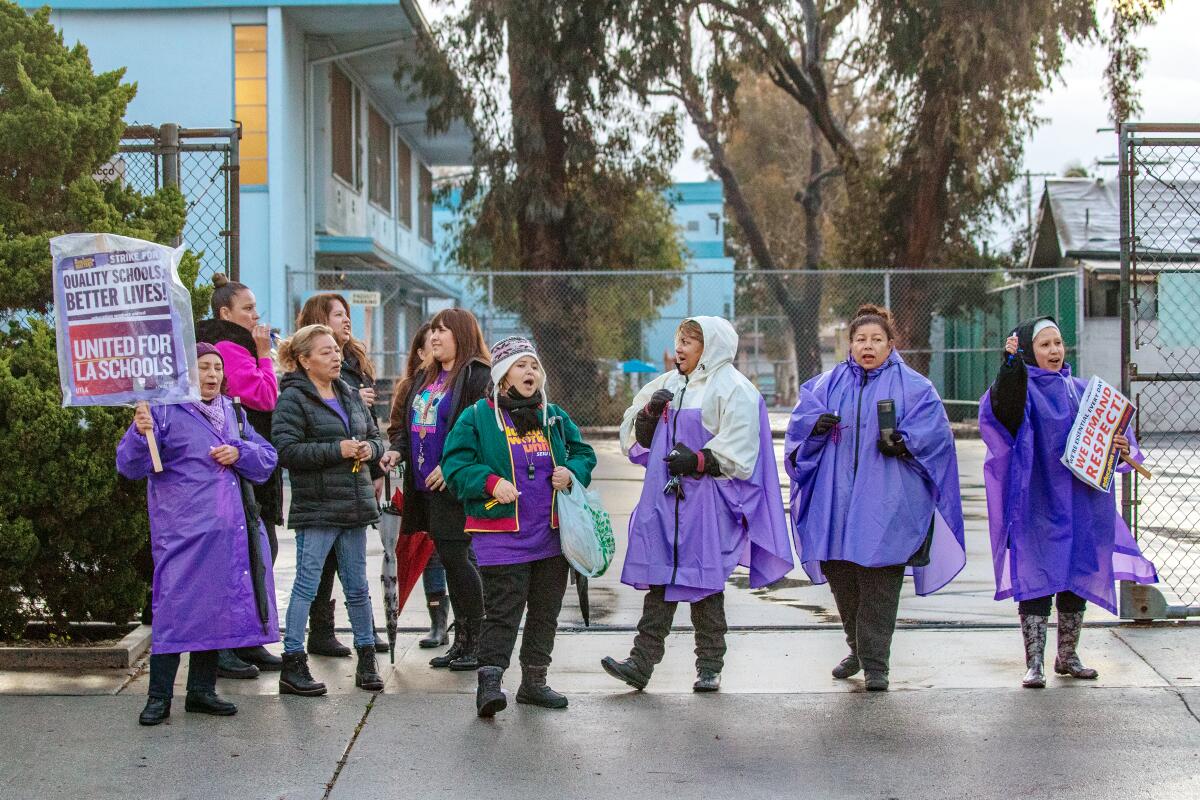
Martinez handed Hernandez a plastic container filled with eggs and potato to share with his co-workers and reminded him to take his gloves as he headed to his school site for a day of picketing in the cold.
She put on a purple poncho to guard against the rain, grabbed the food she had prepared and she and her daughter got in her car and drove to Florence Avenue Elementary, where she greeted her co-workers and began another day on strike.
Times staff writer Andrew Khouri contributed to this report.
More to Read
Sign up for Essential California
The most important California stories and recommendations in your inbox every morning.
You may occasionally receive promotional content from the Los Angeles Times.
